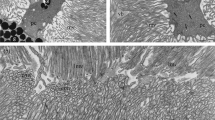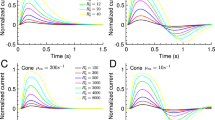Abstract
In experiments on the ventral nerve photoreceptor cells in Limulus the transient absorption changes of the intracellularly pressure-injected calcium indicator dye, Arsenazo III which were evoked by 10 ms intense light flashes were recorded at 645 nm together with the corresponding receptor potential. The Arsenazo signal provided a monitor of the intracellular calcium ion concentration during different experimental conditions.
-
1)
The time between the peak of the Arsenazo signal and that of the receptor potential was shorter (ca. 50 ms) when small amounts of Arsenzo where injected into the cell. This indicates that there may be little or no delay between membrane voltage signal and increase in intracellular calcium.
-
2)
Results obtained under voltage clamp conditions show that the Arsenazo signal depends on the membrane potential. Plotting the amplitude of the Arsenazo signal as function of the time integral of the light induced membrane current signal (which corresponds to the bulk of tranported charge), results in a linear proportionality. This may indicate that the light induced increase in intracellular calcium is due to a constant fraction of the ion current underlying the receptor current.
-
3)
During the time course of dark adaptation following a light adapting flash, two phases of recovery of the amplitude hinT, of the time integral of the receptor potential and of the amplitude AinT of the Arsenazo signal evoked by a constant test flash can be seen (Fig. 5). The first phase correlates with the decrease of the prestimulus level A P of the intracellular calcium ion concentration which had been raised due to the light adaptation. The recovery of the amplitude of the Arsenazo signal and the time integral of the receptor potential appear to be similar both in time course and in relative amplitude of the two phases whereas the recovery of the height hinT of the receptor potential seems to be attenuated in the second phase.
This two-phase recovery indicates the operation of two mechanisms regulating the sensitivity of the photoreceptor. Only the first phase seems to be strongly correlated with the decline of the intracellular calcium ion concentration.
Similar content being viewed by others
References
Bauer P-J (1981) Affinity and stoichiometry of calcium binding by Arsenazo III. Anal Biochem 110: 61–72
Brown JE, Blinks JR (1974) Changes in intracellular free calcium concentration during illumination of invertebrate photoreceptors. J Gen Physiol 64: 643–665
Brown JE, Brown PK, Pinto LH (1977) Detection of light induced changes of intracellular ionized calcium concentration in Limulus ventral nerve photoreceptors using arsenazo III. J Physiol 267: 299–320
Brown JE, Pinto LH (1979) The measurement of intracellular free calcium concentration in squid axon and Limulus ventral photoreceptors using arsenazo III. In: Ashely ChrC, Campbell AK (eds) Detection and measurement of free Ca2+ in cells. Elsevier North-Holland, Biomedical Press, Amsterdam, pp 339–353
Calman BG, Chamberlain SC (1982) Distinct Lobes of Limulus ventral photoreceptors. II. Structure and Ultrastructure. J Gen Physiol 80 (in press)
Cla\en-Linke I (1981) Messung der Hell-Dunkel-Adaptation und ihre Beeinflussung durch die extrazellulÄre Calciumkonzentration. Elektrophysiologische Messungen am Ventralnerv Photorezeptor von Limulus polyphemus. Dissertation an der RWTH Aachen
Cla\en-Linke I, Stieve H (1981) Time course of dark adaptation in the Limulus ventral nerve photoreceptor — measured as constant response amplitude curve —, and its dependence upon extracellular calcium. Biophys Struct Mech 7: 336–337
Fein A, Lisman J (1975) Localized desensitization of Limulus photoreceptors produced by light or intracellular calcium ion injection. Science 187: 1094–1096
Ivens I (1982) Simultane Messungen des lichtinduzierten Ionenstroms in AbhÄngigkeit von der Membranspannung und der intrazellulÄren Calciumionen-KonzentrationsÄnderungen nach Injektion von Arsenazo III. Messungen am Ventralnerv-Photorezeptor von Limulus polyphemus. Dissertation an der RWTH Aachen
Ivens I, Stieve H (1981) Simultaneous measurements of membrane current and intracellular Ca2+ changes using the Ca2+ indicator arsenazo III (Limulus ventral nerve photoreceptor). Biophys Struct Mech 7: 340
Kendrick NC (1976) Purification of Arsenazo III, a Ca2+-sensitive dye. Anal Biochem 76: 487–501
Lisman JE, Brown JE (1972) The effects of intracellular iontophoric injection of calcium and sodium ions on the light response of Limulus ventral photoreceptors. J Gen Physiol 59: 7091–719
Lisman JE, Brown JE (1975) Effects of intracellular injection of calcium buffers on light adaptation in Limulus ventral photoreceptors. J Gen Physiol 66: 489–506
Maaz G, Stieve H (1980) The correlation of the receptor potential with the light induced transient increase in intracellular calcium concentration measured by absorption change of arsenazo III injected into Limulus ventral nerve photoreceptor cell. Biophys Struct Mech 6: 191–208
Maaz G, Nagy K, Stieve H, Klomfa\ J (1981) The electrical light response of the Limulus ventral nerve photoreceptor, a superposition of distinct components-observable by variation of the state of light adaptation. J Comp Physiol 41: 303–310
Meech RW, MackBrown H (1976) Invertebrate photoreceptors: A survey of recent experiments on photoreceptors from Balanus and Limulus. In: Davies P (ed) Perspectives in experimental biology. Vol 1: Zoology. Pergamon Press, London, pp 331–351
Ohnishi ST (1979) A method of estimation of amount of calcium bound to the metallochromic indicator arsenazo III. Biochim Biophys Acta 586: 217–230
Scarpa A, Brinley FJ, Tiffert T, Dubyak GR (1978) Metallochromic indicators of ionized calcium. Ann NY Acad Sci 307: 86–113
Stieve H (1981) Roles of calcium in visual transduction in invertebrates. In: Laverack MS, Cosens DJ (eds) Sense organs. Blackie and Son Ltd, Glasgow and London, pp 163–185
Stieve H (1982) Vision: Transduction of light energy electrical signals in photoreceptor cells. Soc. for Exp. Biol., Symp. 36, The Biology of Photoreceptors. Cambridge University Press, New York
Stieve H, Bruns M (1980) Die EmpfindlichkeitsÄnderung des ventralen Photorezeptors von Limulusbei Helladaptation in AbhÄngigkeit von der extrazellulÄren Ca2+-Konzentration. Verh. Dtsch. Zool. Ges. 1980. G. Fischer Verlag, Stuttgart, p 369
Thomas, MV (1979) Stoichiometry of the calcium-arsenazo III complex. In: Ashley ChrC, Campbell AK (eds) Detection and measurement of the free Ca2+ in cells. Elsevier North-Holland, Biomedical Press, Amsterdam, pp 309–318
Thomas MV, Gorman ALF (1978) Arsenazo III forms a 2∶1 complex with Ca under physiological conditions. Biophys J 21: 53a
Author information
Authors and Affiliations
Rights and permissions
About this article
Cite this article
Nagy, K., Stieve, H. Changes in intracellular calcium ion concentration, in the course of dark adaptation measured by Arsenazo III in the Limulus photoreceptor. Biophys. Struct. Mechanism 9, 207–223 (1983). https://doi.org/10.1007/BF00537817
Received:
Accepted:
Issue Date:
DOI: https://doi.org/10.1007/BF00537817




